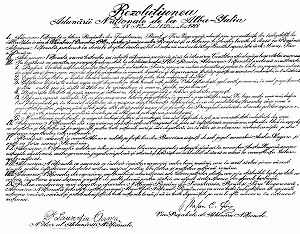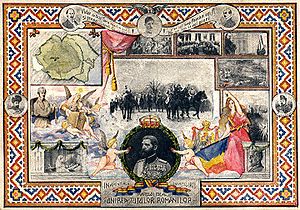- Great Union Day
-
For other uses, see Unification Day (disambiguation).
Great Union Day 
The National Assembly in Alba Iulia
(December 1, 1918)Official name Romanian: Ziua Naţională a României Also called Romanian: Ziua Marii Uniri Observed by Romania Date 1 December Celebrations Military parades (most notably in Alba Iulia and Bucharest), fireworks Observances Te Deum at the Alba Iulia Orthodox Cathedral Great Union Day (Romanian: Ziua Marii Uniri, also called Unification Day[1]) occurring on December 1, is the national holiday of Romania. It commemorates the assembly of the delegates of ethnic Romanians held in Alba Iulia, which declared the Union of Transylvania with Romania.
This holiday was set after the 1989 Romanian Revolution and it marks the unification of Transylvania, but also of the provinces of Bessarabia and Bukovina with the Romanian Kingdom, in 1918.
Prior to 1918, the national holiday of Romania was set to be on May 10, which had a double meaning: it was the day on which Carol I set foot on the Romanian soil (in 1866), and it was the day on which the prince ratified the Declaration of Independence (from the Ottoman Empire) in 1877.
In Communist Romania, the date of the national holiday was set to August 23 to mark the 1944 overthrow of the pro-fascist government of Marshal Ion Antonescu.
Contents
Alba Iulia National Assembly
On December 1, 1918 (November 18 Old Style), the National Assembly of Romanians of Transylvania and Hungary, consisting of 1,228 elected representatives of the Romanians in Transylvania, Banat, Crişana and Maramureş, convened in Alba Iulia and decreed (by unanimous vote)
“ the unification of those Romanians and of all the territories inhabited by them with Romania. ” The Resolution[2] voted by the National Assembly stipulated also the "fundamental principles for the foundation of the new Romanian State". It was conditional, and demanded the preservation of a democratic local autonomy, the equality of all nationalities and religions.
The Assembly also formed from 200 of its members, plus 50 co-opted members a High National Romanian Council of Transylvania, the new permanent parliament of Transylvania.
The next day, on December 2, 1918 the High National Romanian Council of Transylvania formed a government under the name of Directory Council of Transylvania (Consiliul Dirigent al Transilvaniei), headed by Iuliu Maniu.
On December 11, 1918, King Ferdinand signed the Law[3] regarding the Union of Transylvania, Banat, Crişana, the Satmar and Maramureş with the Old Kingdom of Romania, decreeing that
“ The lands named in the resolution of the Alba-Iulia National Assembly of the 18th of November 1918 are and remain forever united with the Kingdom of Romania. ” See also
References
- ^ CIA World Factbook, Romania - Government
- ^ Romanian Institute for Cultural Remembrance, The Resolution of the National Assembly in Alba Iulia on December 1, 1918
- ^ Romanian Institute for Cultural Remembrance, Law regarding the Union of Transylvania, Banat, Crişana, the Satmar and Maramureş with the Old Kingdom of Romania
Bibliography and external links
Categories:- National days
- Unity days
- December observances
- Romanian culture
- Romanian society
- History of Transylvania
- History of Romania
Wikimedia Foundation. 2010.



